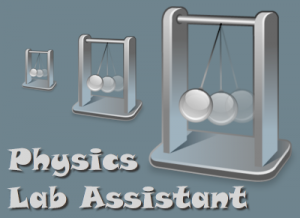
Summary
Physics Lab Assistant was designed for use in the WKU University Physics Laboratory to support new learning objectives for our curriculum, specifically that students would be able to measure physical quantities using sophisticated data acquisition and be able to develop their own experimental procedures. We wanted the application to be easy to use, versatile, computationally powerful, and to support a scaffolded approach as new concepts were introduced. The application, which was developed using LabVIEW, has proven to be very successful in our laboratory and has recently been made available to a wider audience through the LabVIEW Tools Network.
 Physics Lab Assistant is flexible enough to be used for any of our experiments and scalable to work with simple to complex experiments. It allows the students to design their experiment by building a series of waveforms (data evenly spaced in time) from sensor measurements and post-acquisition calculations. Students define acquired waveforms that are measured directly from sensors (such as position, force, temperature), derived waveforms that are derived from these using derivatives, integrals, or Fourier transforms (such as velocity, acceleration, impulse), and calculated waveforms that are built from any of the previous using simple algebra (such as momentum, kinetic energy, potential energy, total energy). Finally students can compute scalar quantities such as average, slope, standard deviation, etc. from a selected region of any of the waveform data. Once an experiment is set up in the software it is easy for the students to perform repeated trials to test different experimental parameters.
Physics Lab Assistant is flexible enough to be used for any of our experiments and scalable to work with simple to complex experiments. It allows the students to design their experiment by building a series of waveforms (data evenly spaced in time) from sensor measurements and post-acquisition calculations. Students define acquired waveforms that are measured directly from sensors (such as position, force, temperature), derived waveforms that are derived from these using derivatives, integrals, or Fourier transforms (such as velocity, acceleration, impulse), and calculated waveforms that are built from any of the previous using simple algebra (such as momentum, kinetic energy, potential energy, total energy). Finally students can compute scalar quantities such as average, slope, standard deviation, etc. from a selected region of any of the waveform data. Once an experiment is set up in the software it is easy for the students to perform repeated trials to test different experimental parameters.
Features and Benefits
- Works with any NI DAQmx-based hardware including myDAQ and ELVIS workstations.
- Supports any analog input based sensor and Pasco Motion Sensors for measuring position.
- Students design their own experiments by choosing what to measure and what to calculate.
- Calculations can be performed on selected regions of acquired and computed waveforms.
- Students can easily perform repeated trials to test different experimental parameters.
- Supports saving data in tab-delimited text, Excel, and Igor Pro formats.
Acknowledgements
This software was developed by Dr. Doug Harper in collaboration with Dr. Scott Bonham both of the Western Kentucky University Department of Physics and Astronomy with support from a CCLI grant from the National Science Foundation entitled “Multidisciplinary Instructional Transformation in Science and Math Courses Supporting Teacher Preparation and Institutional Change”.
